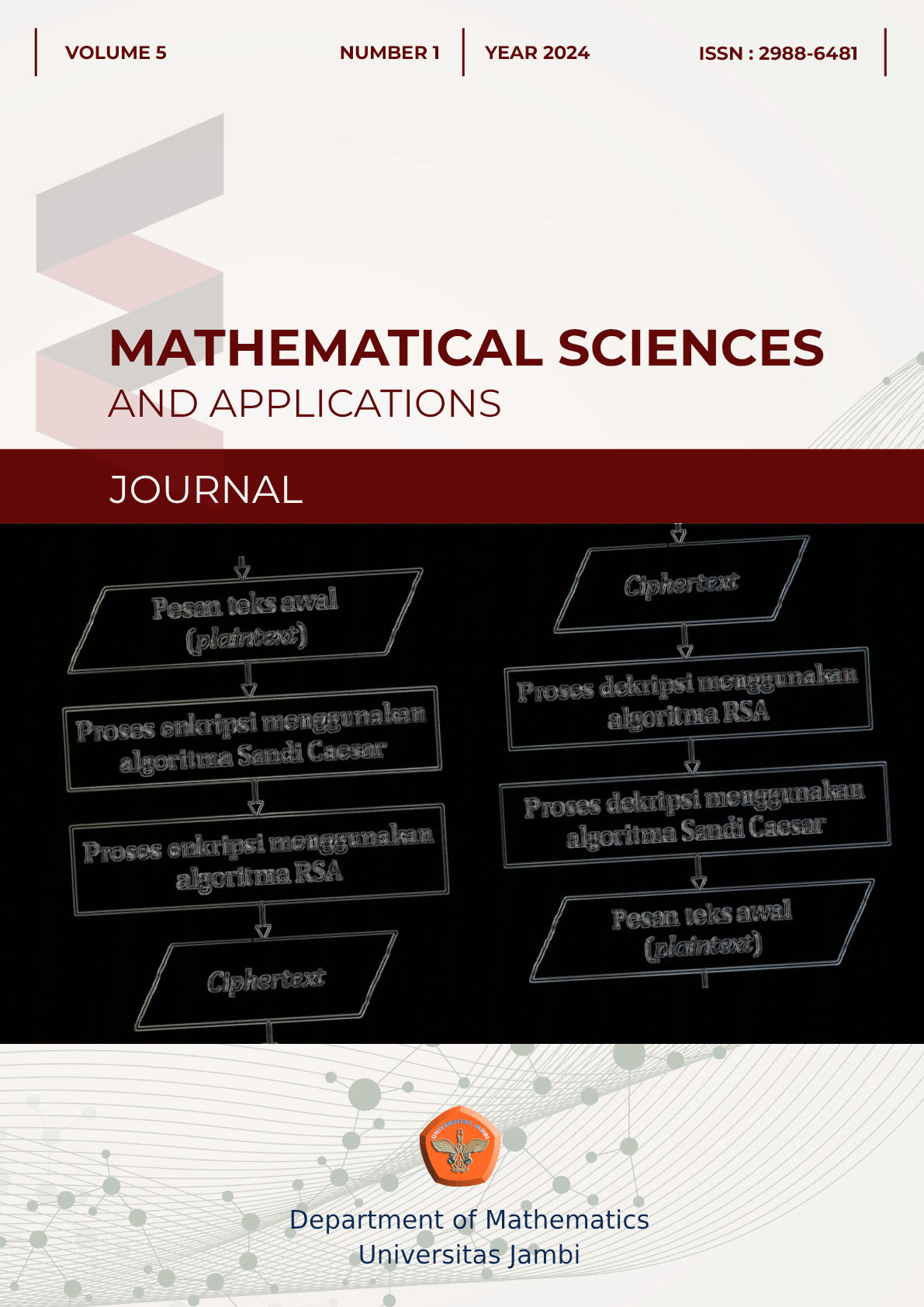Aplikasi Teorema Fermat dalam Kriptografi
DOI:
https://doi.org/10.22437/msa.v5i1.38094Keywords:
Fermat's theorem, Cryptography, RSA algortihmAbstract
Cryptography is the science and technique of disguising messages in a unique form so that they can only be read and processed by the intended recipient. Many studies have been conducted to develop algorithms that can be used to encode information in a way that is difficult to crack and cannot be recognized by adversaries. One example of the most popular algorithms is the Rivest-Shamir-Adleman (RSA), which uses different key pairs for the encryption and decryption process of messages, usually known as the public key and private key. In public key-based encryption systems such as RSA, Fermat's theorem plays an important role because it enables modular exponential calculations on key pairs to be performed efficiently and provides a security basis for the RSA algorithm. Thus, this research aims to describe the application of Fermat's theorem in the RSA algorithm, where the encryption and decryption process involves modular exponentiation with public and private keys. As a result, using the properties of modular exponentiation in Fermat's theorem, this system ensures information remains secure from attacks by third parties without access to the private key, even if they succeed in intercepting encrypted messages. It can be concluded that Fermat's theorem plays a crucial role in establishing a solid mathematical foundation for creating secure and efficient cryptographic systems.
Downloads
References
Jabnabillah, F., & Margina, N. 2022. Analisis Korelasi Zhang, X., & Wang, G. (2012). Efficient RSA Encryption Algorithm Based on Teorema Fermat. Journal of Networks, 7(6), 992–999.
Galbraith, S. D. (2013). Mathematics of Public Key Cryptography. Cambridge University Press.
Silverman, J. H., & Hoffstein, J. (2014). An Introduction to Mathematical Cryptography. Springer Science & Business Media.
Barak, B., & Boneh, D. (2018). Modern Cryptography and the RSA Algorithm. Journal of Cryptology, 31(2), 347–368.
Chaum, D., Roeschlin, M., & Vaudenay, S. (2020). Advances in Cryptology – EUROCRYPT 2020. Lecture Notes in Computer Science, 12100, 58–77.
Bernstein, D. J. (2017). Post-Quantum Cryptography. Nature, 549(7671), 188–194.
Shoup, V. (2015). A Computational Introduction to Number Theory and Algebra. Cambridge University Press.
Lindell, Y. (2019). Foundations of Modern Cryptography. Springer Nature.
Katz, J., & Lindell, Y. (2020). Introduction to Modern Cryptography. CRC Press.
Takagi, T., et al. (2016). Post-Quantum Cryptography: Practical Challenges and Future Directions. IEEE Transactions on Information Forensics and Security, 11(6), 1116–1128.
Domven Lohcwat., et al. (2022). An Application to Cryptography using Fermat’s Theorem. International Journal of Innovative Science and Research Technology, vol. 7.
Guo, Q., et al. (2018). Efficient Modular Exponentiation Algorithms for RSA Cryptosystems. IEEE Transactions on Computers, 67(3), 367–381.
Childs, A. M., & van Dam, W. (2018). Quantum Algorithms for Factoring and Discrete Logarithms. SIAM Journal on Computing, 31(2), 345–377.
Yakubu, D. G., Mathias, L. B., Lucy, B. G. and LohcwatDomven. (2018) Extension of Affine Hill cipher using rhotrices in the polyalphabetic cipher systems, Abacus J. Math. Asso. Niger. 45(1) 273-284.
Delfs, H., & Knebl, H. (2007). Introduction to Cryptography: Principles and Applications. Springer
McAndrew, M. A. (2015). Public-Key Cryptosystem Using Fermat’s Little Theorem. Mathematics of Computation, 43(!68), 425-437.
Guo, Q., et al. (2018). Efficient Modular Exponential Algorithms for RSA Cryptosystems. IEEE Transactions on Computer, 67(3), 367-381.
Hoffstein, J., Pipher, J., & Silverman, J. (2008). An Introduction to Mathematical Cryptography. Springer Science.
Lin, J., Chen, Y., & Song, H. (2021). The Algebra Homomorphic Encryption Scheme Based on Fermat’s Little Theorem. IEEE Xplore.
Yang, Z., & Liu, Q. (2023). Exploring the Advantages and Challenges of Fermat NTT in FHE. Springer.
Gao, X., & Fan, L. (2020). Modular Integer Arithmetic for Public Key Cryptography. Springer.
Shi, D., & Yuan, F. (2019). Efficient Modular Exponentiation Using Fermat’s Theorem. IEEE Xplore.
Meelu, P., & Malik, S. (2010). RSA and its Correctness through Modular Arithmetic. AIP Conference Proceedings, 1324(1), 463-466.
Reges, S. (2013). Modular Arithmetic and RSA Encryption. University of Washington.
Aziz, S., Shoukat, I.A., Murtaza, M., & Lee, C. (2024). Next Generation Block Ciphers: Achieving Superior Memory Efficiency and Cryptographic Robustness for IoT Devices. Cryptography, 8(4).
Meng, W., & Chen, J. (2022). Advances in Applied Cryptography: Theory and Practice. International Journal of Applied Cryptography, 4(3), 120-13.








